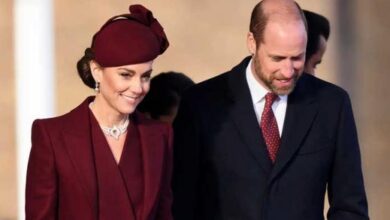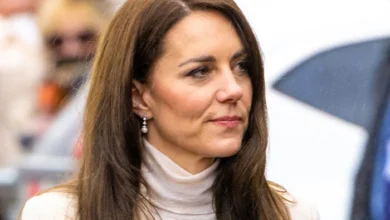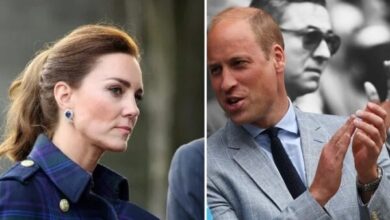Kate Middleton Under Fire for Turning Cancer Video Into an Advertisement

In a surprising turn of events, Kate Middleton, the Princess of Wales, has come under criticism following the release of her much-anticipated video statement on completing chemotherapy.
What many saw as a heartfelt and inspiring message about her battle with cancer and the struggles faced by her family, others—including senior editor Tim Teeman of The Daily Beast—have interpreted as a veiled “advertisement.”
The critique came shortly after Kate posted the video to her social media platforms, sharing her relief at having completed chemotherapy and reflecting on the emotional toll that her nine-month journey has taken on her family.
The video, which was well-received by her followers, quickly went viral, with many praising the Princess of Wales for her transparency and openness about a deeply personal experience.
However, in a sharp commentary, Teeman described the video as being more of a marketing tool than a genuine outreach to those struggling with cancer.
In his Daily Beast article, he accused Kate of using her illness as a platform to “sell” herself, likening her actions to those of Prince Harry and Meghan Markle, who have been open about leveraging their personal experiences for their various media ventures.
Teeman’s critique was direct and scathing. He drew a comparison between Kate’s video and the emotional openness often exhibited by Prince Harry and Meghan Markle.
According to Teeman, without the Sussexes’ ground-breaking interview with Oprah Winfrey and Harry’s subsequent memoir Spare, it’s unlikely that Kate would have opened up so candidly in her video.
Teeman’s argument is that Prince Harry and Meghan Markle’s willingness to share their personal lives has shifted the royal family’s dynamic, forcing other members to be more emotionally transparent.
“Without Harry and Meghan’s leading the way with their Oprah confessional, all the dish of Harry’s memoir, and the general, emotional openness the pair have propagated, would we be seeing Kate talking about her feelings so openly while running through wheat, and blissing out in celestial sunbeams?” Teeman wrote.
In addition, Teeman took aim at the media’s reaction to the video. Just hours after Kate’s video went live, Netflix released a promo for Prince Harry and Meghan’s latest series, which was met with widespread media backlash for its timing.
According to Teeman, this was ironic because the Sussexes have always been transparent about their brand and the fact that they are selling a product, whereas Kate’s video, though wrapped in nobler messaging, was also, in his view, an attempt to sell an image.
Teeman’s analysis suggests that Kate’s video is not just a personal reflection on her cancer journey, but rather a calculated effort to boost her public image.
He claimed, “The Kate cancer video is also a selling tool—but couched and centered in the recovery from trauma. It may have a nobler frame, but it is still an advertisement.”
This critique posits that the royal family, and Kate in particular, are not immune to the realities of branding and public relations.
Teeman believes that the video serves a dual purpose: it humanizes the future Queen while subtly reinforcing the brand of the royal family as resilient, relatable, and strong in the face of adversity.
He suggests that Kate’s decision to make her health struggles public could also be seen as a strategic move to garner sympathy and support, just as Harry and Meghan have used their personal experiences to shape their public personas.
Teeman’s criticism has sparked a lively debate. On one side are those who agree with his assessment, believing that the royals, including Kate, are acutely aware of their public image and use every opportunity to bolster it.
These critics argue that, much like the Sussexes, Kate and William are involved in a type of “soft power” marketing, using their personal stories to reinforce their status as beloved public figures.
On the other hand, many have pushed back against this narrative, seeing it as unnecessarily harsh and reductive.
For them, Kate’s video represents something far deeper: a woman, wife, and mother bravely confronting one of life’s greatest challenges and offering hope to others who may be facing similar battles.
They argue that criticizing someone for sharing their experience with cancer, particularly when such openness is often lauded for raising awareness, is unfair and diminishes the courage it takes to speak so candidly about personal struggles.
Supporters of the Princess of Wales have highlighted the positive impact of her message.
In speaking publicly about her cancer treatment, Kate is not only offering comfort to those in similar situations but also raising awareness about the emotional toll of illness.
They argue that the video serves a far more noble purpose than simply reinforcing her public image, as Teeman suggests.
Teeman’s commentary also brings into focus a larger question: to what extent are public figures allowed to share their personal experiences without it being viewed as self-promotion?
In the age of social media and constant public scrutiny, it can be difficult to draw the line between genuine vulnerability and calculated branding.
The Sussexes have long been accused of using their personal lives for financial gain, and Teeman’s argument implies that Kate may not be all that different in this regard.
However, many would counter that sharing personal struggles, particularly with something as universal as cancer, should not be viewed through a cynical lens. Rather, it can be a powerful tool for connecting with people and offering support.
The debate over Kate Middleton’s cancer video is emblematic of the complex relationship between public figures and their audiences.
Whether viewed as an inspiring message of hope or a calculated PR move, the video has undoubtedly made an impact.
As the Princess of Wales continues her recovery, the conversation surrounding the role of personal narratives in shaping public perception is likely to persist.
In the meantime, Kate’s supporters will continue to rally behind her, inspired by her bravery in the face of adversity.
Whether or not this is part of a larger “advertisement” for the royal family, as Teeman suggests, one thing remains clear: Kate’s message has resonated with countless people around the world, and her influence as a figure of resilience and grace remains undeniable.






